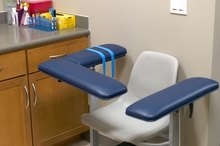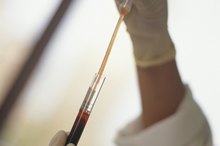Uses of the Radioactive Iodine 131
Radioactive iodine 131 is one of the most important isotopes in the environment. According to the Environmental Protection Agency, radioactive iodine 131 has a very short half-life of about eight days, which means that it decays almost completely in the environment within months 1. Radioactive iodine 131 is widely used for medical purposes.
Treatment of Hyperthyroidism
Hyperthyroidism is a condition in which the thyroid gland is overactive and produces too much of the hormone thyroxine. As a result, the body’s rate of metabolism is accelerated and presents with sudden weight loss, a rapid or irregular heart rate, sweating and nervousness or irritability. Physicians use radioactive iodine 131 to slow the overproduction of thyroxine. The staff of RadiologyInfo explains that a team of specialists, including a radiologist, possibly endocrinologist, oncologist and thyroid surgeon oversee the treatment 4. When a patient swallows a prescribed dose of radioactive iodine 131, the majority of the isotope is absorbed by the body. Most of the residual is excreted through the urine during the first two days following the procedure. Any remaining amounts are eliminated through the saliva, sweat, tears, vaginal secretions and feces. A patient is advised to avoid close, prolonged contact with other people for several days following treatment.
- Hyperthyroidism is a condition in which the thyroid gland is overactive and produces too much of the hormone thyroxine.
- Any remaining amounts are eliminated through the saliva, sweat, tears, vaginal secretions and feces.
Treatment of Thyroid Cancer
What Is Low TSH?
Learn More
Rapidly dividing cells, including cancer cells, are highly sensitive to radiation exposure. The staff of the World Nuclear Association states that short range radiation therapy, also referred to as brachytherapy, is becoming the main treatment for thyroid cancer 3. Radioactive iodine 131 is commonly used to treat thyroid cancer. The isotope is directly implanted or administered to the target area. Brachytherapy reduces overall radiation to the body, localizes radiation to the tumor and is cost effective.
- Rapidly dividing cells, including cancer cells, are highly sensitive to radiation exposure.
- Brachytherapy reduces overall radiation to the body, localizes radiation to the tumor and is cost effective.
Diagnostic Imaging
The thyroid gland absorbs iodine. For this reason, a radioactive iodine uptake test is a useful diagnostic imaging procedure. Nuclear medicine is a division of diagnostic imaging that uses small amounts of radioactive isotopes, such as radioactive iodine 131, to diagnose a variety of diseases and abnormalities in the body. The isotope or radiotracer is injected into a vein, swallowed or inhaled as a gas. After a brief rest period of less than 30 minutes, the radiotracer accumulates in the body and gives off energy in the form of gamma rays. The energy is detected with a PET scanner, gamma camera or a probe. Together with a computer, the amount of radiotracer that is absorbed is measured and images of the thyroid are produced. The radiotracer breaks down naturally and is eliminated in urine and feces during the first few hours or days following the procedure.
- The thyroid gland absorbs iodine.
- Together with a computer, the amount of radiotracer that is absorbed is measured and images of the thyroid are produced.
Related Articles
References
- U.S. Environmental Protection Agency: Iodine
- RadiologyInfo.org: Radioiodine (I-131) Therapy for Hyperthyroidism
- World Nuclear Association: Radioisotopes in Medicine
- RadiologyInfo.org: Thyroid Scan and Uptake
- American Thyroid Association. Iodine Deficiency. 2020.
- Eastman CJ, Zimmermann MB. The iodine deficiency disorders. In: Feingold KR, Anawalt B, Boyce A, et al., editors. Endotext. South Dartmouth, MA: MDText.com, Inc. Updated February 6, 2018.
- Ahad F, Ganie SA. Iodine, Iodine metabolism and Iodine deficiency disorders revisited. Indian J Endocrinol Metab. 2010;14(1):13-17.
- Kostoglou-athanassiou I, Ntalles K. Hypothyroidism - new aspects of an old disease. Hippokratia. 2010;14(2):82-87.
- American Thyroid Association. Hypothyroidism in Children and Adolescents. 2020.
- National Institutes of Health, Office of Dietary Supplements. Iodine. Updated July 9, 2019.
- U.S. National Library of Medicine. Congenital hypothyroidism. Updated February 11, 2020.
- Johnson LE. Iodine. Merck Manual Professional Version. Updated October 2018.
- Murthy MB, Krishnamurthy B. Severe irritant contact dermatitis induced by povidone iodine solution. Indian J Pharmacol. 2009;41(4):199-200. doi:10.4103/0253-7613.56069
- Puchalski AR, Chopra IJ. Radioiodine treatment of differentiated thyroid cancer despite history of 'iodine allergy'. Endocrinol Diabetes Metab Case Rep. 2014;2014:130084. doi:10.1530/EDM-13-0084
- Schabelman E, Witting M. The relationship of radiocontrast, iodine, and seafood allergies: a medical myth exposed. J Emerg Med. 2010;39(5):701-707. doi:10.1016/j.jemermed.2009.10.014
- National Institutes of Health, Office of Dietary Supplements. Iodine. Updated July 9, 2019.
- American Cancer Society. Radioactive Iodine (Radioiodine) Therapy for Thyroid Cancer. Updated March 14, 2019.
- Centers for Disease Control and Prevention. Potassium iodide (KI). Updated April 4, 2018.
- Kalra S, Unnikrishnan AG, Sahay R. The hypoglycemic side of hypothyroidism. Indian J Endocrinol Metab. 2014;18(1):1-3.doi:+10.4103/2230-8210.126517
Writer Bio
Maryann Gromisch is a registered nurse and a freelance writer. She has clinical experience in medical, surgical and critical care nursing. Since October 2009 she has written articles related to the digestive system for Empowher.com, a women's health online magazine. She has a bachelor's degree in nursing from Southern Connecticut State University, New Haven.






